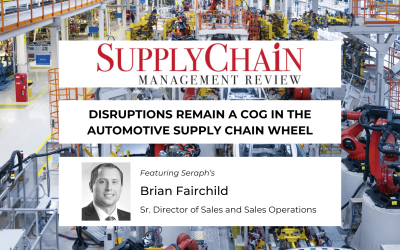Meet the team is a series by Seraph, where junior team members lead conversations with senior Seraph consultants to learn from their experiences.
Today we present a conversation with Chris Trower who leads and supports engagements at Seraph with 25+ years of experience in manufacturing & logistics. Chris previously worked for companies including Abaco Systems, Faurecia, Wayne Industries, and the Gates Corporation.
Planning for perfection causes problems
Justin Fortier: What are some of the most common warehouse mistakes that lead to Seraph being brought into a crisis?
Chris Trower: Planning for perfection. When perfection doesn’t happen, the plant violates its standard processes. An idealized plan assumes that:
- Everything’s is be picked up and dropped off at precisely the right time
- Lines run as intended
- Dunnage loops of empties inside and outside the plant work perfectly
When those assumptions falter, the warehouse layout is violated, and there isn’t enough space for empties, finished goods, and raw materials.
Many of these factors are external to the plant, but once you start violating that warehouse layout, then you begin abandoning your standard processes and putting things wherever you can find space. That creates a vicious cycle. The cycle count team has difficulty cycle counting, inventory accuracy goes down, and the material procurement team then runs blind to what they have. This means that they most likely end up ordering too much of the wrong material, which then further makes your warehouse not appropriately sized. It turns into a vicious cycle. As we’ve come in many, many times, solving this is about setting the warehouse back in order and making a plan that allows for some flexibility as things don’t go perfectly, and driving inventory down to the appropriate level. Then all of a sudden, things start working well.
Planning that everything’s going to work perfectly doesn’t work at all in the real world.
The whole operation is connected, issues are solved systematically, not individually
J: Production schedules become crazy once the plan gets violated, which requires more remaking and revising. It sounds like that’s a similar thing here where you make a warehouse plan, and then you just keep changing, and all the revisions just get worse.
C: If a warehouse is designed to hold 1.5 days of finished goods and suddenly, an OEM shuts down for a day or a shift, the warehouse is overwhelmed. People just start making adjustments on the fly, “I’ll put this over here in the corner…etc.” The result is inventory management starts to fall apart.
Production scheduling is similar. Once behind, without excess capacity, there is a constant need to react to any material shortage, which further drives capacity down because of unnecessary changeovers. It’s all interconnected.
The second most common mistake we see is not truly connecting the dots across the whole operation. There may be a concept of how the injection molding department should be run, but it isn’t complete.
For example: “Set every tool every two and a half days.”
A problem arises if the warehouse wasn’t sized to accommodate that. This creates the pattern of running until either racks (dunnage) or space runs out. Unexpectedly changing becomes the norm. By not connecting the dots between the warehouse layout, the material movement plan, the production plan, and the capacity plan, the system runs out of control.
External warehouses need to be short term fixes
J: When a firm has planned for perfection, adding an external warehouse needs to happen sometimes. Do you have any best practices or things you have found to make adding an external or off-site warehouse successful?
C: My recommendation on external warehouses is those need to be short term fixes. It’s best to have all the material in-house. In a crisis with excess inventory, an appropriate plan may be to move some of the material out so that the plant can breathe. Still, at the same time, there needs to be a plan to eliminate that external warehouse. It’s best to have everything inside.
If you’re going to have it outside, you need to have a very clear plan on managing that inventory and how to cycle material into and out of it. An external warehouse functions as a decanting center for bring material in. Material comes over in smaller lots to the production facility but needs to be part of the planning, logistics, material, and information flow.
We see so many people falter because they open an external warehouse and dump a bunch of inventory in there. Then, they act as if it is still operating inside their facility. It’s not. An external warehouse needs to be treated like a supplier, where the material is ordered on a set cadence and a set time. A person or a team (depending on the operation’s size) must be responsible for scheduling deliveries into the main plant.
Excess inventory is a sign of poor inventory accuracy
J: One example you gave for having too much inventory was an OEM shut down. When Seraph supports a crisis, how do you help determine the appropriate level and layout for the inventory?
C: In the logistics world, a Plan For Every Part (PFEP) is the guiding document that defines every action. If an OEM shuts down, that’s a short-term event. Depending on how long your lead times are to your supply base, defines how long you can get out of that short-term event. An automotive OEM shut down for a day or a shift (because a different supplier shut them down, they had equipment issues, etc.) will make those vehicles up, and there is a need to manage through the short term.
Typically, when we go into a supplier, a common problem you see is they have way too much inventory, but they are still running out of components. That is a function of once warehouse capacity is exceeded, standard operating procedures are violated, which leads to low inventory accuracy. The planners no longer know what they have. They are running blind. The old saying in materials management is, “you get in trouble for having too much inventory, you get fired for not having enough.” Planners will tend to keep ordering through uncertainty to avoid running out of anything. It snowballs. When you see the “smoke” of excessive inventory, you know “fire” inside the warehouse is usually related to inventory accuracy. Planners don’t know what they have.
J: Then they start cycle counts, and things like that get the system in check?
C: You have to get a clear count. I’m not a big fan of cycle counting because if the warehouse is disorganized because of holding excess inventory, it’s already operating so outside what the plan is.
For example, if a warehouse designed to hold $5 million in inventory has $15 million in inventory and an external warehouse. Cycle counters don’t know where it is, so they can’t cycle count.
A clean point needs to be established to know what the actual inventory is. Get a good physical inventory and set the warehouse back in order. Set it so that everybody knows where everything is. If that includes going out and getting an external warehouse for six months, that’s what you need to do. But, it has to be set in order with standard procedures. Otherwise, you’ll cycle count your way right into more inventory problems.
Management dedication is required to restore order
J: What steps are needed to get something back in order? How does that happen?
C: Like everything, it’s about management dedication to do whatever it takes to get things set back in order and to understand the value of material flow into the plant. A manufacturing facility runs best when it hits a rhythm of production. It’s logistics’ job to set the drumbeat by which the rest of the plant runs to. Getting back in order requires getting reorganized and reset up so that everybody knows exactly where the material is, and exactly how it’s going to move from point A to point B, and what the triggers are to call for that material to be delivered to the line. Then it’s up to the management team and the frontline managers (supervisors, team leads) to hold people accountable that the standard processes are not violated. The processes are done the same way every time.
Every time Jeff Jaisle hears somebody say, “well, people aren’t following the standard process,” he laughs and replies, “well, that’s obvious, or the company is so incompetent, they designed a standard process that could not work,” which is not usually the case.
Typically, there have been so many barriers put in front of people that they have no choice but to do whatever they think they have to do at that moment to keep the line running. Then that turns into a vicious cycle. So, you have to reestablish order, reestablish what you know you have and where it is and how it moves from point A to point B, then follow the process.
A PFEP should be a living document, not a singular task
J: What is a management tool that’s commonly misapplied? Or said differently – what typically not done to the level of rigor required to be effective?
C: The closer to just-in-sequence to the end customer, the more critical logistics and material planning become because there’s no inventory in between the supplier and the OEM to be able to accommodate some fluctuations. Some inefficiencies can be covered up with inventory, but that doesn’t happen in close proximity.
In general, people tend to undervalue the role of logistics material planning and production scheduling in the overall manufacturing process. They focus on manufacturing and product development and miss the non-value add of logistics as a very important part of it. In doing so, they neglect to develop a robust, well-defined Plan For Every Part (PFEP). When a PFEP is neglected, workarounds develop, and pressure builds within the facility. A PFEP needs to be the center point of the logistics, materials, and production scheduling process. It is the bookkeeper, the Bible of truth for the PC&L group.
J: What tips do you have for making sure your PFEP is well thought out, other than just being complete?
C: Every PFEP for every organization will be slightly different. It’s a matter of making sure that all the available stakeholders have input have reviewed it and understand it.
A common failure point is giving it to some material planner with the directive “we’re supposed to have a PFEP, go develop it.” A good PFEP takes into account:
- How the production is line run
- The production line cycle time
- The tack time of the customer
- How material is fed to the line
- How transactions are tracked in the system
- How material is received and how often
- Where material is stored
- How material is moved to the line
- The quantities of material movement
- The frequency of moves
When a PFEP is underdeveloped, it’s typically because it was developed by one person sitting behind the computer, not collaborative business process to develop and maintain that plan. PFEPs must be treated as a living document that will change just like an FMEA.
About Seraph:
Seraph’s team of operational managers and senior consultants intercede on our client’s’ behalf to fix a crisis that is putting the business at immediate risk, turnaround a situation that is damaging the bottom line or restructuring to improve the balance sheet. Seraph has successfully delivered projects in the following regions: The Americas, Europe, China, and India. Seraph’s Industry Expertise Includes Aerospace, Automotive, Energy Infrastructure, Healthcare, and Medical Devices. Through our other operating companies, we are continually looking for distressed situations where we can put our expertise and capital to work to create value.






